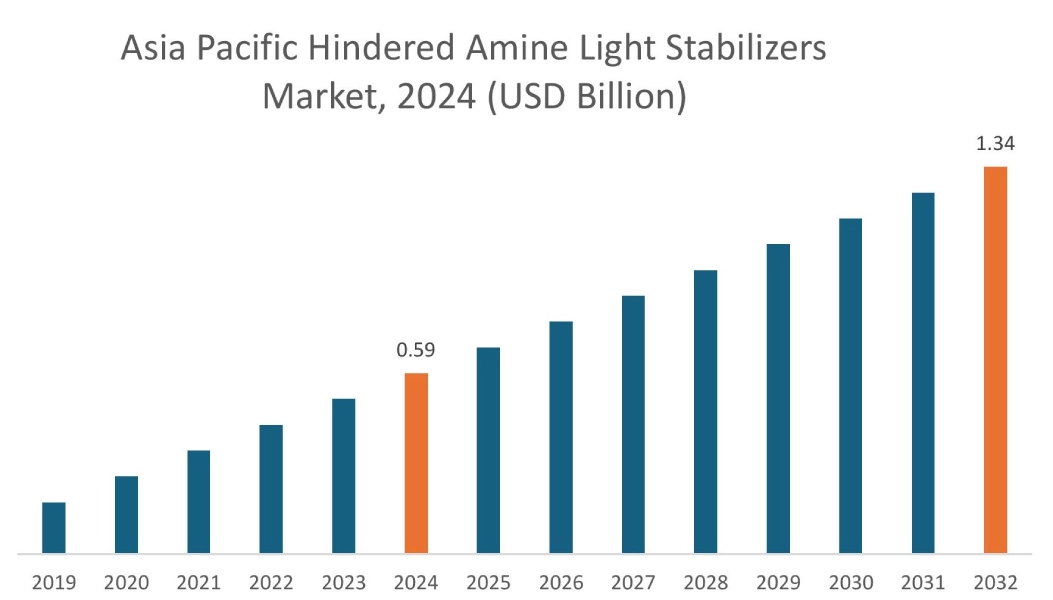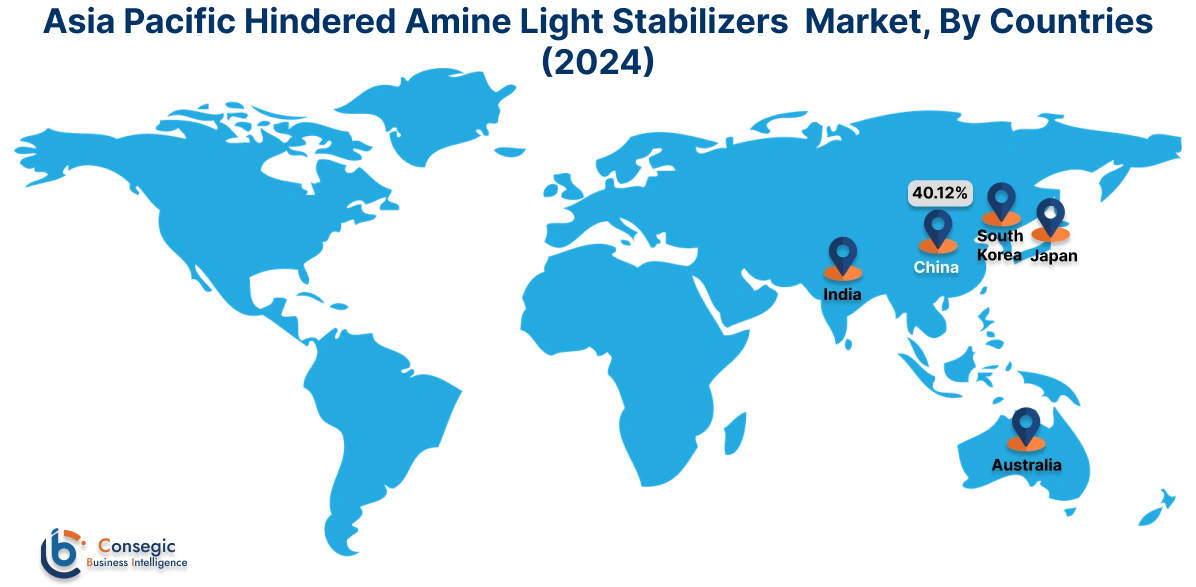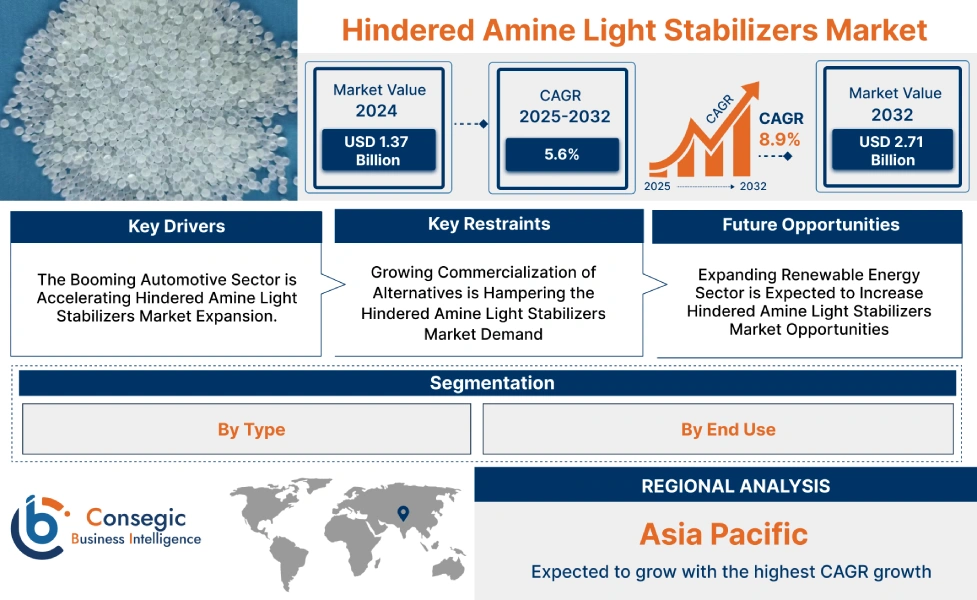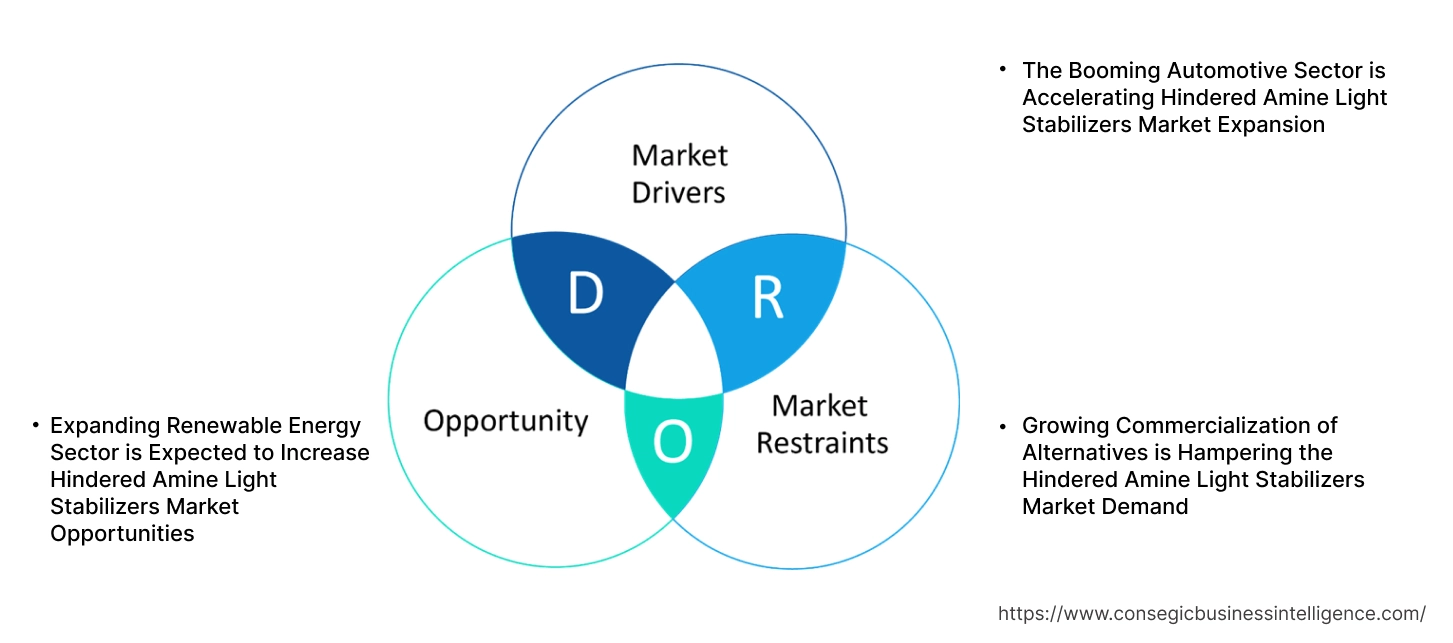Hindered Amine Light Stabilizers Market Size:
Hindered Amine Light Stabilizers Market size is growing with a CAGR of 8.9% during the forecast period (2025-2032), and the market is projected to be valued at USD 2.71 Billion by 2032 from USD 1.37 Billion in 2024. Additionally, the market value for the 2025 attributes to USD 1.49 Billion.
Hindered Amine Light Stabilizers Market Scope & Overview:
Hindered amine light stabilizers (HALS) are a class of chemical compounds. They are manufactured through multi-step organic chemistry processes. It involves the reaction of tetramethylpiperidine derivatives with various reagents. This is to form monomeric, oligomeric, and polymeric structures. The molecular weight of these chemical compounds influences properties such as volatility and compatibility. They are primarily used as additives in polymers to protect them from degradation caused by ultraviolet (UV) radiation. Key other properties include high efficiency, long-term stability, low volatility, and minimal migration within the polymer. They are particularly effective at maintaining color, gloss, and mechanical properties.
Hindered Amine Light Stabilizers Market Dynamics - (DRO) :
Key Drivers:
The Booming Automotive Sector is Accelerating Hindered Amine Light Stabilizers Market Expansion.
Hindered amine light stabilizers are used in different automotive parts such as bumpers, side claddings, rocker panels, body panels, mirror housing, door handles, trim, dashboards, instrument panels, door panels, and seat components amongst others. They prolong the life of these parts by preventing photodegradation, which leads to embrittlement, cracking, and loss of mechanical strength. This reduces the need for frequent replacements and repairs. Moreover, they effectively prevent color fading, yellowing, gloss loss, and chalking among others. This ensures the vehicle maintains its visual appeal over time. This is crucial for both exterior and interior components exposed to sunlight. Environmental electric vehicles, driven by environmental concerns and government incentives, have led to growth, driving the demand for these light stabilizers.
For instance,
- According to the International Energy Agency, global electric car sales surged by 35% in 2023, exceeding 2022 figures by 3.5 million units, thus positively impacting hindered amine light stabilizers market trends.
Overall, the booming automotive sector is significantly boosting the hindered amine light stabilizers market expansion.
Key Restraints:
Growing Commercialization of Alternatives is Hampering the Hindered Amine Light Stabilizers Market Demand.
Future Opportunities :
Expanding Renewable Energy Sector is Expected to Increase Hindered Amine Light Stabilizers Market Opportunities.
Hindered amine light stabilizers are crucial in renewable energy applications. This is to ensure the long-term performance and durability of outdoor infrastructure exposed to constant sunlight. They are added to wind turbine blades and composite blades, which helps them maintain structural integrity and surface quality. Moreover, they are also incorporated into solar panels, junction box materials, and cable insulation to protect against UV degradation. Additionally, they are also used in plastic components of solar tracking systems, wiring, and housing for electrical equipment. Increasing demand for clean energy has led to sector growth, hence positively impacting hindered amine light stabilizers market trends.
For instance,
- According to Ars Technica, in the first quarter of 2025, wind energy production increased by 12%, while solar energy production grew by 44% compared to the previous year, creating potential for the market.
Overall, expanding the renewable energy sector is expected to increase the hindered amine light stabilizers market opportunities.
Hindered Amine Light Stabilizers Market Segmental Analysis :
By Type:
Based on type, the market is categorized into polymeric, monomeric, and oligomeric.
Trends in Type:
- There is a growing trend of using polymeric types of amine light stabilizers as they provide superior long-term stability and low volatility.
- Growing usage of oligomeric type to impart benefits such as good thermal stability is also a rising trend.
The polymeric segment accounted for the largest market share in 2024
- Polymeric stabilizers have a high molecular weight. Their high molecular weight ensures they remain effective over extended periods. This makes them ideal for applications requiring decades of outdoor exposure.
- Due to their dimension, they are less prone to evaporating from the polymer matrix during processing to the surface during use. This provides consistent protection.
- They are vital in industries requiring extreme performance. This includes automotive (exterior parts, clearcoats) and construction (roofing membranes, siding, window profiles) among others. Growth in these industries is driving the segment.
- For instance, according to Real Estate Japan, Japan’s new housing construction increased by 6.6% in year 2021 when compared to 2020.
- Overall, as per the market analysis, the aforementioned factors are driving a segment in the hindered amine light stabilizers market growth.
The oligomeric is expected to grow at the fastest CAGR over the forecast period.
- Oligomeric stabilizers have an intermediate molecular weight. This bridges the gap between smaller monomeric and larger polymeric. Their structure typically consists of a few hindered amine units repeated.
- They offer a compelling balance of properties, exhibiting lower volatility and migration than the monomeric type.
- This leads to better long-term UV protection while providing better compatibility and ease of dispersion in polymers compared to some high molecular weight polymeric HALS.
- They maintain their effectiveness even under elevated processing temperatures during polymer manufacturing. Their larger mass makes them less prone to being extracted from the polymer by water or solvents. This makes them more utilized in agriculture and packaging.
- Overall, as per the hindered amine light stabilizers market analysis, the aforementioned factors will drive a segment in the market.
By End-Use:
Based on end-use, the market is categorized into automotive, construction, paints & coatings, packaging, agriculture, chemical, energy, and others.
Trends in the End-Use
- A trend towards longer-lasting, low-VOC, and high-performance paints and coatings, especially for outdoor industrial and architectural applications, increases the need for effective hindered amine light stabilizers.
- The usage of hindered amine light stabilizers in packaging to prevent yellowing and degradation is also a rising trend.
The automotive segment accounted for the largest market share of 37.66% in 2024.
- Hindered amine light stabilizers increase the lifespan of automotive parts by preventing embrittlement.
- They are also helpful in preventing cracks and loss of mechanical strength caused by photodegradation.
- They effectively prevent color fading, gloss loss, and chalking. This ensures the vehicle's appearance remains vibrant over time. Rising disposable incomes have led to an increase in demand for passenger cars, hence driving this segment in the market.
- For instance, according to Autovista24, German passenger car production grew by 11% in 2022, when compared to 2020.
- Overall, as per the market analysis, the aforementioned factors are driving the segmental share in the hindered amine light stabilizers industry.
The energy segment is expected to grow at the fastest CAGR over the forecast period.
- Hindered amine light stabilizers are increasingly vital in the energy sector to ensure the longevity and efficiency of critical outdoor infrastructure.
- In solar panels, they are incorporated into polymer components such as backsheets, encapsulants, junction boxes, and cable insulation.
- For wind turbines, they are used in the composite materials and fiberglass of the blades to protect their surfaces, as well as in other external plastic parts.
- They prevent the photodegradation, yellowing, and embrittlement of plastics and composites caused by continuous UV radiation and environmental exposure. This is crucial for assets designed to operate for 20-30 years.
- Thus, according to market analysis, the aforementioned factors will drive the segment in the hindered amine light stabilizers market growth.

Regional Analysis:
The regional segment includes North America, Europe, Asia Pacific, the Middle East and Africa, and Latin America.

In 2024, Asia Pacific accounted for the highest hindered amine light stabilizers market share at 43.15% and was valued at USD 0.59 Billion and is expected to reach USD 1.34 Billion in 2032. In Asia Pacific, the China accounted for the hindered amine light stabilizers market share of 40.12% during the base year of 2024. There is robust automotive growth and its associated infrastructure development in the region. Countries such as China, India, Japan, South Korea, and Southeast Asian nations are witnessing sustained development in vehicle production and sales.
For instance,
- According to CEIC Data, motor vehicle sales in South Korea grew by 14.7% in 2025, when compared to the previous year.
Hindered amine light stabilizers are essential in providing crucial UV protection and long-term durability to these automotive parts. They prevent material degradation and protect the structural integrity of vehicles in diverse and often harsh APAC climates. This sustained need for high-performance, weather-resistant automotive materials directly fuel the market’s expansion. Overall, the growing automotive sector is driving the market in the region.

In Europe, the hindered amine light stabilizers market is experiencing the fastest growth with a CAGR of 7.9% over the forecast period. There is a growing packaging sector in the region. This is fueled by evolving consumer demand and stringent sustainability goals. Europe's strong focus on product quality and extended shelf life, especially for food, beverage, and personal care items, necessitates robust protection for plastic packaging. Hindered amine light stabilizers are crucial in this sector to prevent UV degradation, discoloration, and loss of mechanical properties in plastic films, bottles, and containers. This ensures products maintain their visual appeal, prevents migration of harmful substances, and preserves the integrity of contents sensitive to light.
North America’s hindered amine light stabilizers market analysis indicates that several key trends are contributing to its growth in the region. The construction industry is expanding in the region. This is driven by significant investments in residential, commercial, and infrastructure projects across the U.S. and Canada. Plastics and composites are increasingly being utilized in outdoor construction applications such as PVC siding, roofing membranes, window profiles, and outdoor piping, where they are constantly exposed to harsh weather conditions. Hindered amine light stabilizers are essential here to prevent photo-oxidation, cracking, fading, and brittleness, ensuring these materials maintain their structural integrity and aesthetic appeal over decades.
Middle East and Africa (MEA) market analysis indicates that there is a rising chemical industry in the region. Countries benefit from abundant and cost-effective petrochemical feedstocks such as oil and gas. This leads to substantial investments in the extension of its downstream chemical and polymer production capacities. Hindered amine light stabilizers are crucial for ensuring the durability and performance of these locally produced polymers. Given the often harsh and high-UV environments in many parts of the MEA, incorporating these stabilizers protects them from rapid degradation, maintaining their quality, color, and mechanical properties.
Latin America's region creates potential for the market. The agriculture sector is undergoing rapid transformation in the region. Countries such as Brazil are major global agricultural producers. They are increasingly adopting modern farming practices and technologies to boost productivity and meet rising global food requirements. Hindered amine light stabilizers are incorporated into greenhouse films, mulch films, and irrigation systems to prevent damage from sunlight and other environmental factors. They work by neutralizing free radicals caused by UV exposure, preventing polymer degradation. For instance, Tinuvin NOR 371 is a high molecular weight stabilizer designed for agricultural films, including those exposed to agrochemicals.
Top Key Players and Market Share Insights:
The Hindered Amine Light Stabilizers market is highly competitive with major players providing products to the national and international markets. Key players are adopting several strategies in research and development (R&D) and product innovation to hold a strong position in the global Hindered Amine Light Stabilizers market. Key players in The Hindered Amine Light Stabilizers industry include-
- BASF SE (Germany)
- Clariant AG (Switrzerland)
- SONGWON Industrial Co., Ltd. (South Korea)
- SI Group, Inc. (United States)
- Suqian Unitechem Co., Ltd. (China)
- Adeka Corporation (Japan)
- 3V Sigma (United States)
- Rianlon Corporation (China)
- SABO S.p.A. (Italy)
- Syensqo SA/NV (Belgium)
Hindered Amine Light Stabilizers Market Report Insights :
| Report Attributes | Report Details |
| Study Timeline | 2019-2032 |
| Market Size in 2032 | USD 2.71 Billion |
| CAGR (2025-2032) | 8.9% |
| By Type |
|
| By End-Use |
|
| By Region |
|
| Key Players |
|
| North America | U.S. Canada Mexico |
| Europe | U.K. Germany France Spain Italy Russia Benelux Rest of Europe |
| APAC | China South Korea Japan India Australia ASEAN Rest of Asia-Pacific |
| Middle East and Africa | GCC Turkey South Africa Rest of MEA |
| LATAM | Brazil Argentina Chile Rest of LATAM |
| Report Coverage |
|
Key Questions Answered in the Report
How big is the Hindered Amine Light Stabilizers market? +
In 2024, the Hindered Amine Light Stabilizers market is USD 1.37 Billion.
Which is the fastest-growing region in the Hindered Amine Light Stabilizers market? +
Europe is the fastest-growing region in the Hindered Amine Light Stabilizers market.
What specific segmentation details are covered in the Hindered Amine Light Stabilizers market? +
Type and End-Use segmentation details are covered in the Hindered Amine Light Stabilizers market.
Who are the major players in the Hindered Amine Light Stabilizers market? +
BASF SE (Germany), Adeka Corporation (Japan), 3V Sigma (United States), Rianlon Corporation (China), SABO S.p.A. (Italy), and Syensqo SA/NV (Belgium) are some major players in the market.


